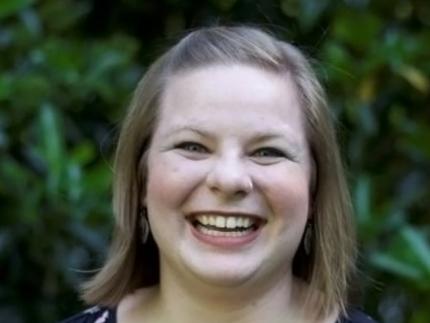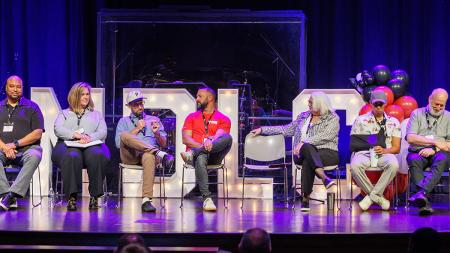Gathering around the Table

Nutritionists sometimes talk about the foods we eat as being building blocks for our bodies. After all, “You are what you eat.” In her January Series presentation, Kendall Vanderslice suggested that shared meals can also be building blocks for community.
Speaking at Calvin University on Monday, Jan. 22, Vanderslice discussed the two tables that bring people together in the church: the communion table and the fellowship table.
In many churches, communion is a cornerstone of worship, reminding believers of Christ’s sacrifice and our salvation, and drawing our hearts into communion with him and with each other as his followers.
The meal we share in communion tells a story. Like the Passover meal it models, communion in the church tells a story of deliverance, said Vanderslice, and continues to represent God’s leading and saving presence among his people.
Vanderslice went on to say that meals are a natural place for storytelling. The meal itself can tell a story – of shared recipes, new cultures, or cooking techniques; and of the efforts that brought the food from soil to plate. But a shared table is also a natural place for people to tell their stories and to hear those of others.
For this reason, she said, the table of fellowship is also important in building relationships and, ultimately, a church community.
Food and community are mentioned all through the Bible, said Vanderslice. For example, God created Adam out of the soil and gave him the task of tending the earth. The earth produced food of every kind, and yet the man was alone. So God crafted a companion. From this, Vanderslice suggested, we can see that humanity has two basic needs: nutrition from food and the companionship of other people.
Another image of food involves stolen fruit through which sin entered God’s creation, noted Vanderslice. When Adam and Eve ate from the one tree God had commanded them not to eat from, humanity’s communion with God was broken, and brokenness of every kind followed as a consequence.
But, Vanderslice explained, “This meal of forbidden food is not the only life-changing, world-altering meal in Scripture.” The gospel accounts, for example, are full of stories about Jesus eating and sharing food with others. And “it’s through food that Jesus demonstrates God’s commitment to healing and restoration. On his last night, Jesus offers his disciples a meal. He tells them, ‘Eat, drink, remember me.’”
One small eating brought death, said Vanderslice, but Jesus instituted a meal before his death to show that life is coming. When we share the bread and cup in the sacrament of communion, we remember that Jesus came to bring us fullness of life. Yet when we share in the communion meal, we don’t feel “full.” Vanderslice explained that communion purposefully leaves us a bit unsatisfied; there is more to long for and look forward to. In this way, she said, the meal holds in tension the brokenness and the restoration of community in the church and the world.
In another picture of food from the Bible, Acts 2 talks about the church communing regularly around tables. Their shared meals involved all believers, including people of different social levels and genders, breaking societal norms at the time as a picture of Christ’s kingdom. That’s why, explained Vanderslice, Paul was so concerned about the way the church in Corinth had been celebrating communion: they had been missing the importance of eating together. The poor went hungry while the rich feasted and got drunk, making a mockery of the meaning of the meal Christ had instituted (see 1 Corinthians 11:17-22).
Sharing meals as a church family – with church suppers and potlucks, meals shared among a few families and individuals together, and fellowship around the table – builds and sustains community, said Vanderslice. “In many places, though, communal meals are considered a luxury, optional to church life, rather than a natural and necessary outpouring of the life of our church.” We are busy; conversations can become awkward or dull or even painful. Slowing down can feel like a waste of time.
However, said Vanderslice, there is a cost to loneliness and stress. For individuals and at a society level, our failure to slow down and share life and stories and meals contributes to social and cultural polarization, emotional distress and depression, and health impacts. When we slow down, sit down, and share food, we gain nuance, understanding, stronger relationships, and better health.
Vanderslice founded Edible Theology, described online as a “nonprofit organization that fosters connection through stories about food, shared around the table. This creates spaces where everyone can be known, valued, and loved—by God and by each other.” The Edible Theology Project offers various curricula on food and theology, helping Christians connect the two and grow their hospitality. “If you’re . . . longing for more community and fellowship, I hope you’ll consider introducing this curriculum into your life,” shared Vanderslice. “But you don’t need a curriculum. Invite people for spaghetti or cups of ramen. Recognize the shared need for food and for one another.”
God offered us a meal of bread and wine as a cornerstone of worship because it’s the sharing of food that helps to bring food and healing and restoration, said Vanderslice. The sharing of meals in community forms relationships that allow us a taste of the healing of God here and now.
For people unsure about how to start conversations when they invite people for a meal, Vanderslice suggested two prompts: “tell a story about a meal that was very meaningful,” and “tell a story about a meal that was very awkward.” From the stories that emerge, we can learn more about the places people come from, their family traditions, and more. “It’s fun on the surface and becomes a way into conversations about so many other things,” said Vanderslice.
If there is tension, Vanderslice noted, it’s important to remember that meals and conversations can be tense because we love each other. “We care about [others], and that’s why we care what they think, and that’s why it matters that we disagree. How do we focus on that care? The table becomes a place where we can start to sort those questions out. The silly story-starters can relieve some of the tensions and remind us why we care about each other.”
It takes time and commitment to build relationships and community, said Vanderslice, but if we commit to the time, the effort, and the people, we participate in God’s church and grow better to love God and our neighbors.


